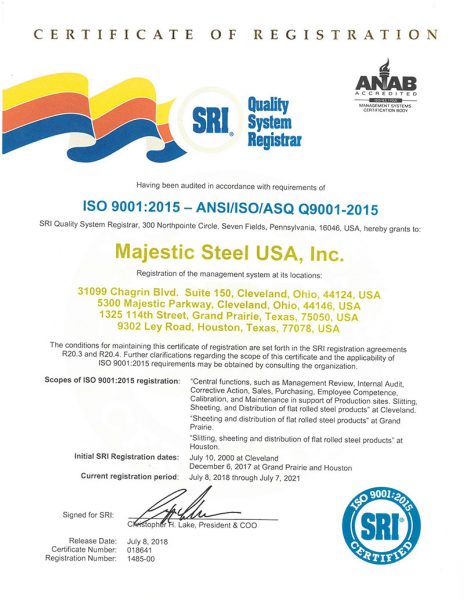Market Update | September 14, 2022
TENTATIVE AGREEMENTS WITH RAILROAD CARRIERS
Eight out of twelve labor unions have reached tentative agreements with the railroad carriers, up from five last week. A “cooling off” period expires on Friday, at which time workers can strike, but railroad representatives stress that the negotiations are ongoing and a strike is not inevitable. However, if they do strike and idle all 7,000 long distance daily freight trains in the U.S. would require more than 460,000 additional long-haul trucks every day, which is not possible based on equipment availability and an existing shortage of 80,000 drivers.
Input Costs
The recent up and down movement for zinc subsided this week, as pricing remained relatively flat from last week.
-
-
Zinc pricing came in at $1.46/lb this week, remaining below $1.50/lb for the second straight week.
-
Spot iron ore pricing rebounded slightly again this week, ending a streak of four consecutive weekly declines.
-
-
Spot iron ore pricing is currently at $104.25/mt, up 7.1% from the end of last week and is now flat on a m/m basis.
-
Pacific Basin met coal pricing was virtually flat once again this week.
-
-
Current pricing is at $271.50/mt, flat from the end of last week and up 23.4% from this time last month.
-
Australia has declared a La Nina event in the tropical Pacific, which indicates above average rainfall for the rest of 2022.
-
-
This is the third La Nina weather trend in a row, increasing the chances of above average rainfall across already saturated ground and filled water storage in east and north Australia.
- Heavy rainfall, storms, flooding and saturated ground in New South Wales (NSW) and Queensland has disrupted coal mining, railing and shipping, as well as coal-bed methane (CBM) development to supply gas to export LNG.
-
After initial expectations of a flat to up slight movement for prime scrap pricing in September, uncertainty around domestic production and excess supply in the pipeline ultimately led to a further price slide.
-
-
September Chicago #1 busheling came in at $385/gt, down $20/gt from August and is now down $375/gt from the recent peak in April.
- Chicago busheling is now at its lowest price since December 2020.
-
Supply
Domestic raw steel production rebounded slightly last week, after sliding to a 21-month low two weeks ago.
-
- U.S. steelmakers produced 1.723 million tons at an 78.2% utilization rate.
- YTD production is now down 3.8% from the same time last year.
Based on preliminary import licenses, the daily average for September (12 days) is down 10.8% from the daily rate in August.
-
- Excluding volatile slab imports, the daily average is down 16.7% from August.
The recent drop off in on order activity combined with the markets higher reliance on service center inventory helped push flat rolled service center inventory lower in August.
-
- August carbon flat rolled inventory totaled 4.452 million tons, down from July and the lowest month-end total since April.
- The August inventory, combined with the current shipment rate, equates to 1.93 months of supply; down from July and the lowest level since March.
Coated flat rolled inventory increased slightly on the back of weaker coated shipments.
-
- Despite the increase in inventory in August, the total tons on order (691.7k tons) was the lowest monthly total since November 2015.
- The coated inventory, when combined with the coated shipment rate, declined to 1.90 months.
DEMAND
Shipments of tractors and combines, in Canada and the U.S., declined in August, now down for the third time in the last four months.
-
-
Shipments totaled 25,257 units, down 4.8% from July and down 8.6% from 27,641 units from August 2021.
-
This is the sixth consecutive month in which shipments declined on a year-over-year basis.
- When looking on a year-over-year basis, to help smooth seasonality, tractor shipments declined while combine shipments increased 27.0%.
- Year-to-date shipments are now down 13.1% from the same timeframe last year.
-
ECONOMIC
Eight out of twelve labor unions have reached tentative agreements with the railroad carriers, up from five last week.
-
-
Unions, BLET and SMART TD, (Brotherhood of Locomotive Engineers and Trainmen and the SMART Transportation Division) representing half of all rail workers, are stating that there will be no ratification unless quality of life issues including vacation, sick days and attendance policies are addressed.
-
A “cooling off” period expires on Friday, at which time workers can strike, but railroad representatives stress that the negotiations are ongoing and a strike is not inevitable.
- Not sure if this is posturing or has some validity but will be something we are tracking closely.
- However, if they do strike and idle all 7,000 long distance daily freight trains in the U.S. that would require more than 460,000 additional long-haul trucks every day, which is not possible based on equipment availability and an existing shortage of 80,000 drivers.
- Considering that the U.S. economy would nearly implode if trains were to stop running, the federal government has kept close tabs on negotiations for months and is pushing for a resolution. Congress has the power to block a strike from happening if a deal isn’t reached this week.
-
Despite sliding slightly for the second consecutive month, the year-over-year increase in prices paid by consumers is still extremely high.
-
-
Despite sliding, on a month-over-month basis, for the second consecutive month, the Consumer Price Index was up 8.26% from August last year.
-
This is still elevated and above the twelve-month average of 7.67%.
- Prices for all goods, excluding food and energy, increased on both a month-over-month and year-over-year basis.
- The CORE-CPI was up 6.32% from August last year; the highest year-over-year increase since March.
- The largest increase in prices (from last August) came from shelter, which accounted for 40% of the total increase.
- Prices also increased for furniture, medical care, and new vehicles.
-
This material, information and analyses (the “Content”) may include certain statements, estimates and projections prepared with respect to, among other things, historical data and anticipated performance. Content may reflect various assumptions by Majestic Steel USA, Inc. concerning anticipated results that are inherently subject to significant economic, competitive and other uncertainties and contingencies and have been included for illustrative purposes. Content is provided AS-IS.

